Be Mindful of Your Salt Intake for National Salt Awareness Week
 Did you know that salt has been used for centuries as a natural food preservative? Table salt is not only used to preserve food, it is also commonly used to flavor dishes. Salt is an essential mineral that your body needs to function properly. However, using too much salt is can negatively impact your health.
Did you know that salt has been used for centuries as a natural food preservative? Table salt is not only used to preserve food, it is also commonly used to flavor dishes. Salt is an essential mineral that your body needs to function properly. However, using too much salt is can negatively impact your health.
This week is a great time to learn more about salt during N.
The American Heart Association recommends that most Americans consume no more than 2,300 mg of sodium a day. That is a little less than a teaspoon of salt! Salt is found in many of the foods that you eat, some of which you may not even be aware of. Educating yourself on how to identify the sodium content is foods is a great way to make sure you are consuming the right amount of sodium.
Since most foods contain some amount of sodium, eliminating or even reducing salt from your diet can be very difficult. However, there are many other ways to flavor food and watch your sodium intake without compromising flavor.
How to Identify Items High in Sodium
While cooking meals at home is one of the best ways to manage your sodium intake, it is not always feasible to eat a home-cooked meal every day. Even if you are making sure the foods you eat are low in sodium, some other items may be contributing to your sodium.
Here are just some ways to identify high sodium items:
- Read Nutrition Labels: When you look at nutrition labels on the foods you are consuming, be sure to look at both the sodium content and the amount per serving. Aim to keep your sodium intake to under 2,300 mg per day.
- Limit Your Intake of Cured and Smoked Meats: The technique that goes into preserving cured and smoked meats contains high amounts of sodium. Many deli meats are high in sodium, unless they say otherwise. Try to reduce your daily intake of these foods.
- Be aware of Medications with Hidden Sodium: Over the counter medications such as acetaminophen, ibuprofen, and some antacids contain high amounts of sodium.
Ways to Kick Your Salt Habit:
Once you are aware of the amount of sodium in foods, you can take the steps to limit your salt intake and kick your salt habit!
- Season your foods without salt: Try seasoning your foods with other flavor enhancers like garlic, hot sauce, low-sodium seasonings, herbs, and spices.
- Remove the saltshaker from the table: When you take the saltshaker off the table, there is less temptation. You are more likely to use it on your food when it is sitting in front of you, think “out of sight, out of mind”.
- Choose low sodium soups or broths: Soups, broths, and bouillon cubes contain large amounts of sodium. Look for low sodium options when you are grocery shopping.
- Snack smart: Snacks like bars, chips, and crackers tend to contain a high amount of preservatives and sodium. Try to incorporate more fresh fruits and veggies into your diet and limit your intake of high salty snack foods.
Speak with a healthcare professional about your individual sodium needs. Contact me to schedule an appointment.
Your Turn to Action: How will you become more aware of the salt you are consuming this week? Let me know in the comments below.


Leave a Reply
Want to join the discussion?Feel free to contribute!